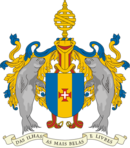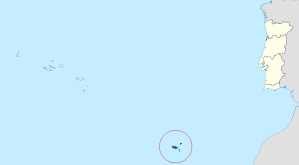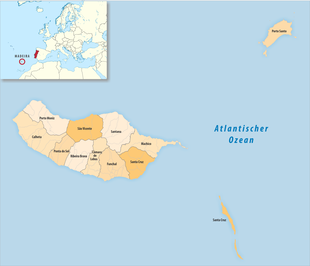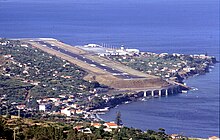Madeira Autonomous Region
|
Região Autónoma da Madeira Autonomous Region of Madeira |
|||
|
|||
| Motto: The ilhas as mais belas e livres | |||

|
|||
| Country | Portugal | ||
| Geographical location | 32 ° 45 ′ N , 17 ° 0 ′ W | ||
| language | Portuguese | ||
| Capital | Funchal | ||
| Other cities | Porto Santo , Machico , Santa Cruz , Câmara de Lobos , Santana , Caniço | ||
| surface | 801 km² (island group M.) | ||
| Population (2010) | 235,166 2.5% of the population of Portugal | ||
| Number of municipalities | 11 | ||
| The highest point | Pico Ruivo (1,862 m) | ||
| President of the regional government | Miguel Albuquerque | ||
| Autonomy since | 1976 | ||
| Time zone |
UTC +0 GMT UTC +1 GMT +1 (March to October) |
||
| International area code | +351 291 | ||
| anthem | Hino da Região Autónoma da Madeira (regional) | ||

The Portuguese Autonomous Region of Madeira is the political entity that consists of the Madeira Archipelago (with the main island of Madeira ), the Ilhas Desertas and the Ilhas Selvagens .
geography
The Madeira Archipelago consists of the main island of Madeira and the smaller island of Porto Santo . To the southeast are the Ilhas Desertas ( Ilhéu Chão , Deserta Grande and Bugio ). Halfway to the Canary Islands are the Ilhas Selvagens .
Residents
Only the islands of Madeira and Porto Santo are inhabited.
history
politics
Regional government
In 1976 Madeira was declared an autonomous region (Região Autónoma da Madeira), which has its own government and parliament. As part of Portugal, it belongs to the European Union . The president of the regional government has been Miguel Albuquerque of the Christian-conservative Social Democratic Party PSD since 2015 .
From 1978 to 2015 the newspaper editor Alberto João Jardim of the PSD was president of the regional government (with a short interruption in 2007 when he resigned in protest against the new law on regional finances, which provided for cuts in financial aid from the state budget). He is considered one of the most controversial politicians in Portugal.
Administrative division
The autonomous region is divided into eleven districts (municípios) .
| circle | Number of municipalities |
Population (2011) |
Area km² |
Density of population / km² |
LAU code |
|---|---|---|---|---|---|
| Calheta | 8th | 11,521 | 111.51 | 103 | 3101 |
| Câmara de Lobos | 5 | 35,666 | 52.14 | 684 | 3102 |
| Funchal | 10 | 111,892 | 76.13 | 1,470 | 3103 |
| Machico | 5 | 21,828 | 68.33 | 319 | 3104 |
| Ponta do Sol | 3 | 8,862 | 46.18 | 192 | 3105 |
| Porto Moniz | 4th | 2.711 | 82.93 | 33 | 3106 |
| Porto Santo | 1 | 5,482 | 42.59 | 129 | 3201 |
| Ribeira Brava | 4th | 13,375 | 65.41 | 204 | 3107 |
| Santa Cruz | 5 | 43.005 | 81.50 | 528 | 3108 |
| Santana | 6th | 7,719 | 95.56 | 81 | 3109 |
| Sao Vicente | 3 | 5,721 | 78.83 | 73 | 3110 |
| Madeira Autonomous Region | 54 | 267,782 | 801.11 | 334 | 3 |
economy
Madeira was one of the poorest regions in Europe until the 1970s. Madeira's GDP per capita in 1974 was only 40% of the average Portuguese GDP. In the following 30 years Madeira caught up economically. Average economic growth over a ten-year period around the turn of the millennium was 5%.
Situation in the mid-2000s
GDP per capita was at times 29% higher than the Portuguese average in the 2000s and was around 80% for the EU-15 (2003) and 72% for the EU-28 (2015). The main source of income is tourism. The regional government planned to increase the number of hotel beds from 29,000 to 39,000. The areas on the north coast and inland in particular should be promoted, while growth in Funchal should be limited. The Madeira International Business Center (IBC) is the second pillar of the Madeiran economy. Even before 2006, several thousand companies were settled here with tax breaks, which created 3,000 direct jobs. The IBC accounted for 21% of Madeira's gross domestic product. Among other things, telecommunications and Internet companies have set up shop that value Madeira for its low VAT rates compared to other European countries. In 2002, for example, the French Internet provider Wanadoo set up shop here . Madeira is increasingly being used by international companies for conferences. Madeira is also the seat of numerous shipping companies and has been the seat of Madeira University since 1988 .
The Madeiran economy was going through a process of transformation. The tourism sector increasingly tried to attract active vacationers (45-65 years old) in order to change its reputation as a retiree's paradise. Therefore, attempts were also made to recruit low-cost airlines. The increase in Portuguese VAT rates from 13% to 15% has deterred some potential investors such as Yahoo , AOL and Apple from investing in Madeira. While the Madeiran regional government tried to negotiate an exemption for Madeira, the Madeiran companies strengthened their profile in the service sector in order to withstand the competition. Madeira was in direct competition with Luxembourg and Cyprus , which also offered VAT rates of 15%.
tourism
Visitors from Great Britain predominate among the guests especially in Funchal and Câmara de Lobos, where Churchill painted. He stayed at the luxury hotel Reid's Palace , which opened in 1891 , is one of the Leading Hotels of the World and the most famous hotel far beyond the island.
Madeira is a traditional holiday destination for the British. On Madeira, however, you also meet tourists from all over Europe - but not too many in total and then mainly east of the capital (Funchal), in Caniço. The relationship between British and German visitors has shifted. Even before 2007, the number of German tourists rose sharply. There are flights to Funchal from Germany on three to four days of the week (as of 2007).
Madeira is known as a hiking paradise, with spring-like to summery, pleasant temperatures all year round. Along the levadas (small water channels, especially in the northern part of the island), Moorish slaves laid paths for maintenance and care a good 300 years ago, which are still well maintained as hiking trails and give grandiose insights and views into the beauty of the island. The core area is the area between Porto da Cruz and Santana in the north ( UNESCO World Heritage Site). The mountain hiking route between the third highest peak Pico do Arieiro and the highest mountain Pico Ruivo is also remarkable . This hike should be started early in the morning - around noon the mountains are often covered in clouds.
There are hardly any beaches in Madeira. However, there are sheltered bathing bays. These are either fortified natural rock bathing bays (for example Lido Galomar in Caniço), natural rock bathing basins like in Porto Moniz , or small artificial sandy beaches (Calheta). In Caniço there has been an underwater national park since 1986 where you can dive and where diving has been done since 1980.
The secondary island of Porto Santo (two to three hours by ferry or 20 minutes' flight), on the other hand, offers a nine-kilometer-long sandy beach, but is not nearly as interesting in terms of landscape (erosion caused by deforestation by the old seafarers).
A total of around 1 million tourists visited the island in 2005, with around 200,000 coming by cruise ship and therefore only staying briefly.
Madeira Island is famous for the quality of its cherimoya fruit . The Annona Festival is traditional and takes place annually in the parish of Faial. This event promotes the consumption of these fruits and their derivatives such as liqueurs, puddings, ice cream and smoothies.
Individual evidence
- ↑ PSD Madeira vence com maioria absoluta , Rádio Renascença , on March 30, 2015 (pt)
- ↑ Eurostat. Retrieved April 15, 2018 .
- ↑ UW National Park: Garajau on Madeira celebrates its 30th anniversary . In: DIVING . April 7, 2016 ( tauchen.de [accessed November 18, 2016]).
- ↑ Caderno de Especificações - Anona da Madeira - Denominação de Origem ( Portuguese ) In: Produtos Tradicionais Portugueses . Agripérola, Cooperativa Agrícola CRL. 1998. Retrieved March 24, 2019.
- ↑ Anona da Madeira DOP ( Portuguese ) In: Produtos Tradicionais Portugueses . Direção-Geral de Agricultura e Desenvolvimento Rural. Retrieved March 24, 2019.
- ↑ Festa da Anona ( Portuguese ) In: Visit Madeira . Direcção Regional do Turismo da Madeira. 2019. Retrieved March 24, 2019.






